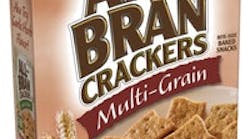|
Related articles Adding fiber and whole grains to the plantwww.foodprocessing.com/articles/2007/033.html Inulin: The 'in' fiberwww.foodprocessing.com/articles/2005/272.html Consumer Taste Test: Double the fiber, double the fun |
It’s a great test question for a beginning nutrition class. How does soluble fiber reduce cholesterol?
We’ve all heard that oats, barley and beans along with select fiber-rich foods can lower cholesterol. But it is not always explained why only soluble fiber works and not the fiber in wheat bran or cellulose. Of course, now we could add the question: What is a probiotic?
When we laud the benefits of fiber, we are really talking about different fibers, each with distinct characteristics. That has never been more apparent than now, as more and more foods emerge that contain some of the newer fibers.
The older view of fiber was that of an inanimate broom sweeping out our digestive tract. We now know that fiber is a much more dynamic part of our diet, one that can supply fuel to the colon and help us gain the greatest energy possible from the food we eat, all the while enhancing digestive health.
Fiber is simply a general term referring to a variety of carbohydrates that escape digestion in the small intestines. This allows them to beneficially affect such diverse processes as rate of digestion, nutrients absorption and the growth of the healthy bacteria that normally reside in digestive tract.
The most straightforward effect of dietary fiber, normalizing transit time, is something doctors paid little attention to until the early 1970s, when Dennis Burkett studied Ugandans and compared their colon health to that of British soldiers stationed in Uganda.
With the newfound appreciation of fiber, Kellogg’s All-Bran brand has been resuscitated and is being extended into products other than cereal.
Burkett observed that the quicker transit time of the Ugandans on a fiber-rich diet coincided with a low risk of cancer and other digestive tract diseases when compared to the British soldiers on a fiber poor diet. That finding launched the modern fiber craze.
Soon it became apparent that the benefits of fiber were as complex as the fibers themselves. Take for example our first test question. How do soluble fibers work to lower cholesterol? It’s simple: They create a cholesterol sink. Unlike the insoluble fibers that keep the action moving through the colon, soluble fibers swell with water and slow movement through the small intestines. In doing so, they trap bile acids squirted into the small intestines from the gall bladder in order to aid fat digestion.
The bile acids, which act as a fat emulsifier, are made from cholesterol by the liver and stored in the gall bladder until we decide to eat fat. The soluble fiber in the diet traps much of the bile acids, preventing their absorption, and escorting them out of the body with the remains of the meal. And since we need more bile acids to digest fats, the liver has to catch up with demand. So, it pulls more cholesterol out of the blood, lowering blood cholesterol in the most harmless possible manner.
When blood sugar became the hot topic, fiber again grabbed the headlines. The same action in the small intestines that trapped cholesterol also slowed the entrance of sugar into the blood. So, you could hardly talk about blood sugar without mentioning the many types of soluble fibers that slowed the entrance of sugar into the blood. They included the pectins and gums of fruits, beans and many grains, and also fibers that were new to us: including inulin, a fructose polymer, and resistant starch, which escapes normal starch digestion in the small intestines because it has an unusually long straight chain or does not completely swell with water.
The newest task to be added to the fiber story is the care and feeding of the normal healthy bacteria that make the intestinal pathway a live and vibrant organ. These friendly bacteria break down some soluble fibers into short chain fatty acids that provide energy to the colon. They also prevent the growth of harmful bacteria, enhance the immune system, and increase absorption of calcium.
We call the healthy bacteria probiotics, and the food that feeds them, prebiotics. Coincidentally, they include the same soluble fibers that slow the absorption of sugar and lower cholesterol.
We now have a more complete picture of fiber and its effect on the multitasking digestive system, which has the immense responsibility of extracting the greatest energy possible from the food we eat. The bottom line is that assuring a fiber-rich diet is a little more complex than asking the simple question: Got bran?


